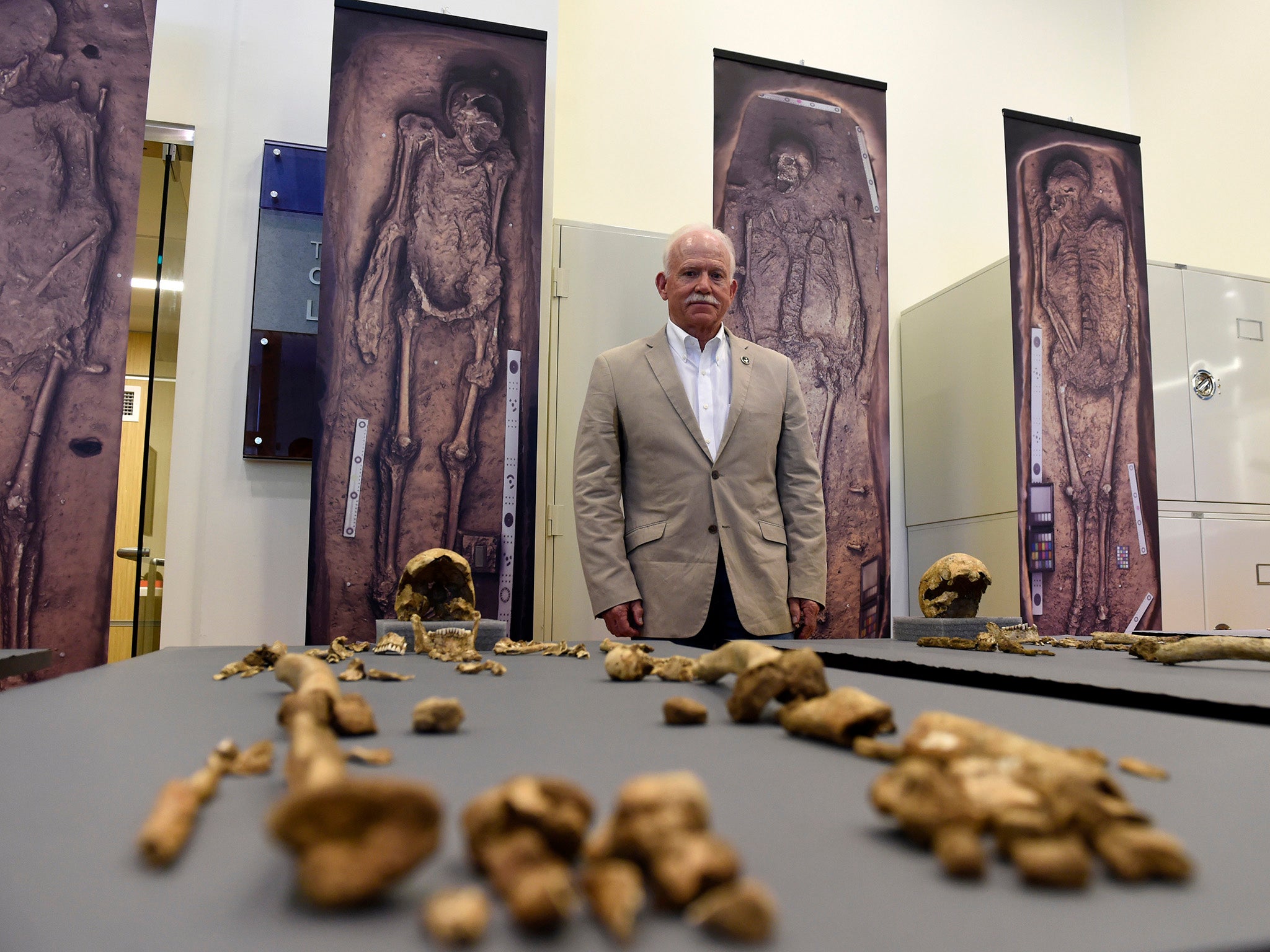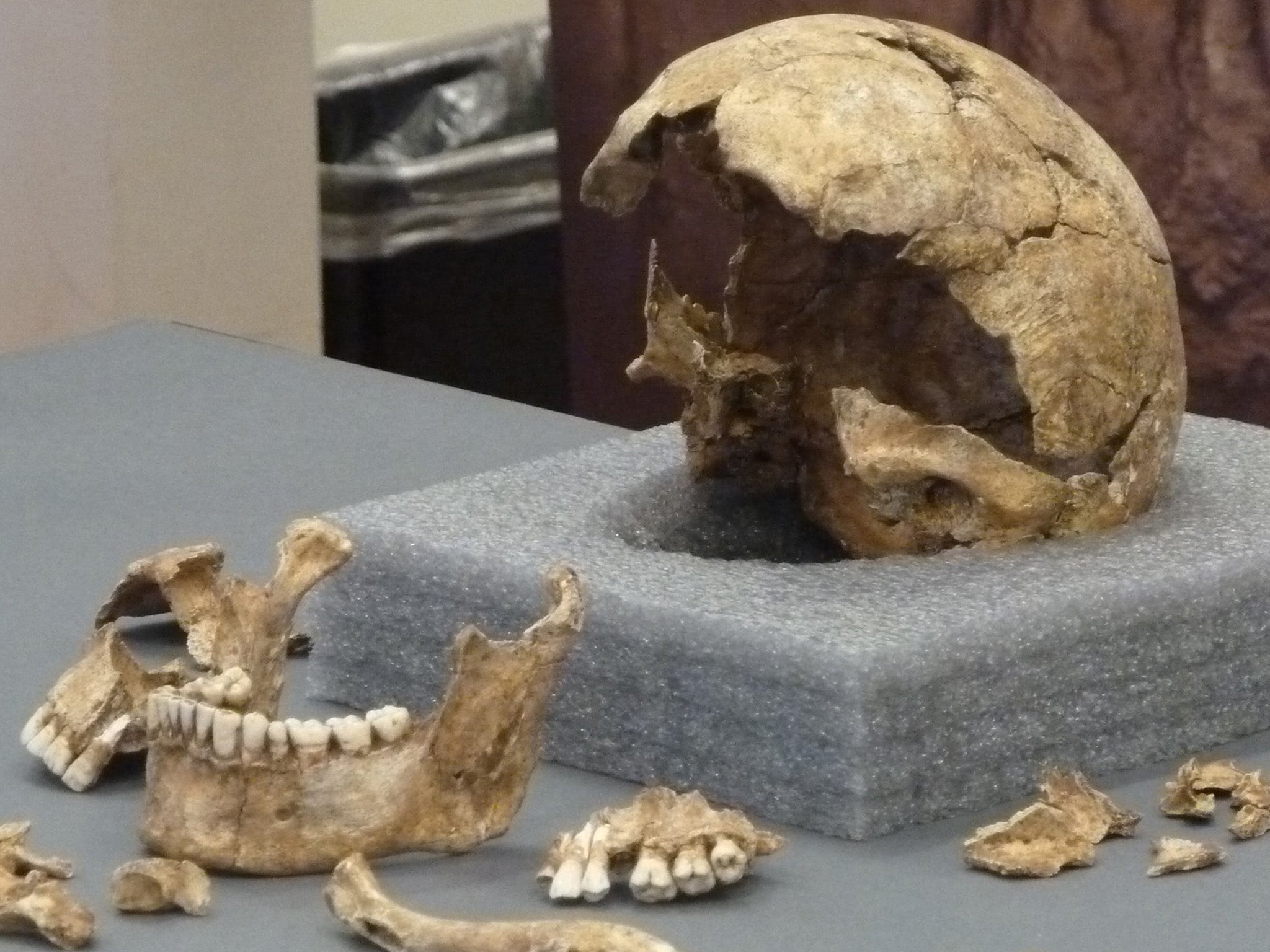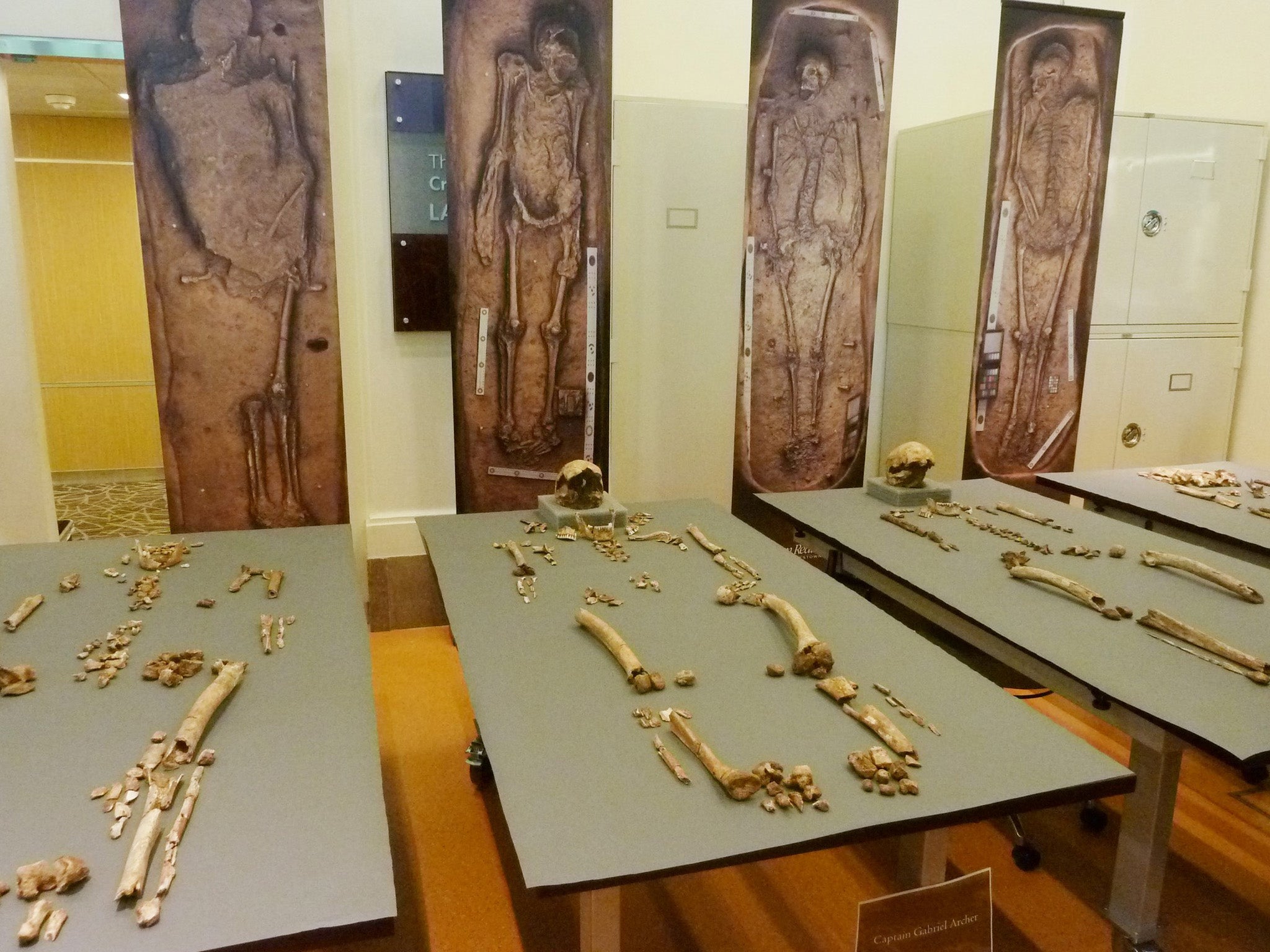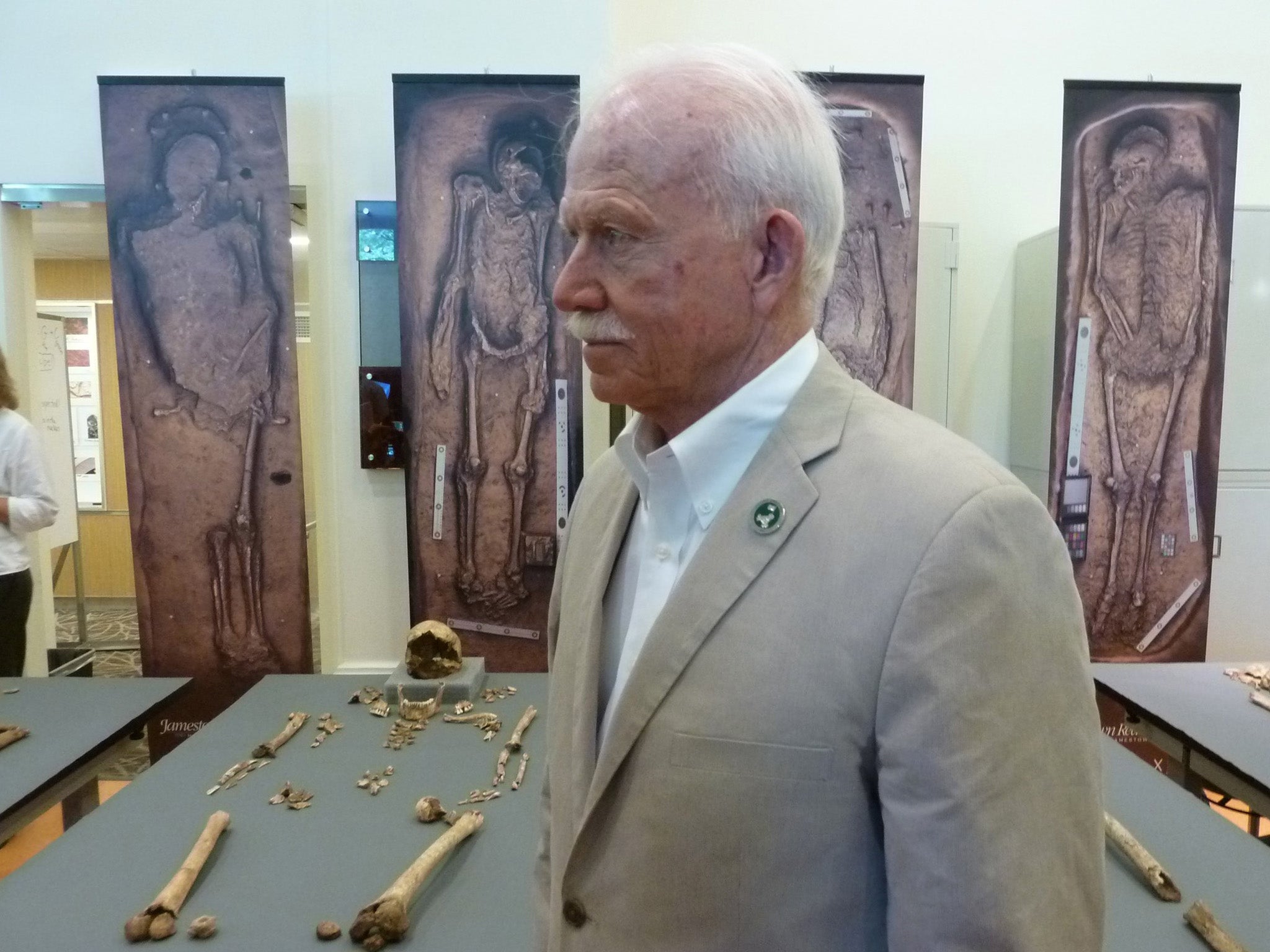Archaeologists discover graves of four founders of Jamestown — and a mystery in a small box
Bill Kelso, director of archaeology at Jamestown Discover, poses with bone fragments of four high-status leaders who helped shape the future of America

Your support helps us to tell the story
From reproductive rights to climate change to Big Tech, The Independent is on the ground when the story is developing. Whether it's investigating the financials of Elon Musk's pro-Trump PAC or producing our latest documentary, 'The A Word', which shines a light on the American women fighting for reproductive rights, we know how important it is to parse out the facts from the messaging.
At such a critical moment in US history, we need reporters on the ground. Your donation allows us to keep sending journalists to speak to both sides of the story.
The Independent is trusted by Americans across the entire political spectrum. And unlike many other quality news outlets, we choose not to lock Americans out of our reporting and analysis with paywalls. We believe quality journalism should be available to everyone, paid for by those who can afford it.
Your support makes all the difference.When his friends buried Capt. Gabriel Archer here about 1609, they dug his grave inside a church, lowered his coffin into the ground and placed a sealed silver box on the lid.
This English outpost was then a desperate place. The “starving time,” they called it. Scores had died of hunger and disease. Survivors were walking skeletons, besieged by Indians, and reduced to eating snakes, dogs and one another.
The tiny, hexagonal box, etched with the letter “M,” contained seven bone fragments and a small lead vial, and it probably was an object of veneration, cherished as disaster closed in on the colony.
On Tuesday, more than 400 years after the mysterious box was buried, Jamestown Rediscovery and the Smithsonian Institution announced that archaeologists have found it, as well as the graves of Archer and three other VIPs.
“It’s the most remarkable archaeology discovery of recent years,” said James Horn, president of Jamestown Rediscovery, which made the find. “It’s a huge deal.”
The discovery, announced during a morning news conference at the Smithsonian’s National Museum of Natural History, deepens the portrait of the first permanent English settlement in North America, established here in 1607.
It also raises intriguing questions about Jamestown’s first residents.
Where did the silver box come from? Are the bones inside it human, as they seem? If so, whose are they? And why was the box placed in Archer’s grave?
Horn said in an interview before the announcement that the box is a reliquary, a container for holy relics, such as the bones of a saint. “It’s a sacred object of great significance,” he said.
Such containers have a long tradition in the Catholic Church and predate the Protestant Reformation. So the appearance of one in post-Reformation Jamestown is mystifying.
Did it belonged to Archer, whose Catholic parents had been “outlawed” for their faith in England? Or to the fledgling Anglican Church, as a holdover from Catholicism?
“More research, more work” is required, Horn said. “Frankly, we need more help with interpreting this.”
Putting pieces together
On a chilly November day in 2013, archaeologist Jamie May reached into the dirt of grave “C,” in what had been the chancel of the church, built inside the walls of James Fort in 1608.
With the thumb and forefinger of her left hand she gripped the little box, and with the other hand gently worked it free with a small wooden tool. As she lifted it out, Director of Archaeology William M. Kelso asked, “Does it feel hollow?”
“Yeah,” she said. “And it feels like there’s something in it.”
It had been three years since the Jamestown archaeologists had come across the huge post holes that outlined the long-vanished church, with the side-by-side graves inside. (The church, itself a historic find, was legendary as the place where the Indian princess Pocahontas married Englishman John Rolfe.)

Now, after months of research and preparation, the Jamestown team, along with anthropologists from the Smithsonian, were excavating the burial sites.
Grave “A” contained the skeleton of the Rev. Robert Hunt, who was about 39 and was the first Anglican minister in the country, experts concluded from records and studies of the remains.
A devout peacemaker from Hampshire, in southern England, he had brought his library with him when he came over in 1607 with the first colonists.
He may have left England, in part, because he suspected his wife was having an affair, according to records reviewed for the Smithsonian by Ancestry.com.
But his books were destroyed in a fire that gutted the compound in 1608, and he died the same year.
Grave “B” held the skeleton of Sir Ferdinando Wainman, who was about 34, “an honest and valiant gentleman,” wrote a friend. He died in 1610 and was buried in a fancy wooden coffin.
Although the coffin had disintegrated, its unusual shape, which included a “head box,” was determined by plotting the outline of the nails that survived.
The “anthropoid” coffin, which slightly resembles those of ancient Egypt, is “one of the few ever found in English America,” Horn said.
Wainman’s bones contained high levels of lead, indicating that he probably dined using pewter plates and goblets, a sign of high status, Horn said.
Grave “C” contained the remains of Archer, who was about 34.

He stood only 5-foot-5 and was among the leading men who arrived in 1607. He was a lawyer and scribe, and his hands had been wounded in a skirmish with Indians.
Archer had terrible teeth, with 14 cavities and two abscesses, said Douglas Owsley, the lead Smithsonian anthropologist, who studied the remains in the field and at the Natural History museum.
Archer was buried in a coffin of white oak, and the silver box was found on top, near his lower left leg.
Grave “D” bore the remains of Capt. William West, who was about 24 and had been killed fighting Indians in 1610 near where Richmond is today. He also was buried in an anthropoid coffin, made by the same carpenter who made Wainman’s, Owsley said.
Remnants of a military sash, fringed with silver thread and tiny metal baubles, were found with his bones.
Owsley said in an interview this month that he does not know how the men died, but that “they died fast.”
The graves — inside the chancel, or altar area, of the timber and mud church — indicated that the occupants were esteemed members of the community.
“It would have been only the prominent who were buried there,” Horn said in an interview this month.
“What we’re learning about are four of the first founders of English America,” he said. “There’s no other way to put it.”
‘We are starved’
In the spring of 1610, three years after the first settlement, two English ships loaded with settlers made their way to Jamestown, filled with anticipation.
What they found was horrifying.

The fort’s palisade had been torn down and the church was crumbling, according to Horn’s history of Jamestown.
It “looked rather as the ruins of some ancient [fortification] than that any people living might . . . now inhabit it,” wrote Sir Thomas Gates, one of the newcomers.
Of the 300 or so colonists who had been there the previous fall, only about 60 emaciated survivors remained. They were “lamentable to behowlde,” Gates wrote, “cryeinge owtt, ‘we are starved. We are starved.’ ”
It was during the previous six months, which had been the worst, that Archer probably died.
“Having fed upon horses and other beasts as long as they lasted, we were glad to make shift with vermin, as [well as] dogs, cats, rats and mice,” George Percy, a Jamestown leader, wrote of that period.
“Famine beginning to look ghastly and pale in every face . . . nothing was spared to maintain life and [settlers did] those things which seem incredible,” he wrote later.
One of those things was cannibalism. In 2012, Jamestown archaeologists found the skull of a girl that bore cut marks, as though it had been carved. Smithsonian anthropologists later determined that she was about 14.
Other people dug up corpses for food, Percy wrote, or went mad and ran off into the woods to be killed by Indians.
There was “a lecture of misery in our people’s faces,” Percy wrote.
Mystery in a small box
On Jan. 22, in the Natural History museum’s electron microscopy lab, Scott Whittaker focused his powerful microscope on the silver box, the size of a salt shaker, illuminated under the lens.
As Owsley and a delegation from Jamestown watched, Whittaker zoomed in on the letter etched on the lid.
Was it an M or a W? For about three hours, Whittaker and the others studied the letter, and the construction of the box.
They were able to figure out the sequence in which the lines were cut, deduced that the carver was probably right-handed, and finally determined that the letter was an M.
But what did it mean? Archer’s mother’s name was Mary. He came from a town called Mountnessing, outside London. “We don’t know what the link is,” Owsley said.
It was one of many questions presented by the 400-year-old box and its contents.
Studies and scans showed that the box was made of non-English silver, and originated in continental Europe many decades before it reached Jamestown.
Horn said he believed it was a sacred, public reliquary, as opposed to a private item, because it contained so many pieces of bone.
“A private reliquary would be like a locket, or a small crucifix, with a tiny fragment of bone,” he said. This probably was for public display and devotion.
Reliquaries usually are associated with Catholics, he said, adding, “What’s that mean for Gabriel Archer?”
Archer was not known to be Catholic. But his parents in England had been “recusants,” Catholics who refused to attend the Protestant Anglican Church, as required by law after the Reformation.
Horn wondered: Was Archer a leader of a secret Catholic cell? In 1607, George Kendall, a member of the settlement’s governing council, was executed as a Catholic spy, according to Jamestown Rediscovery, and Horn said Tuesday, “I’m beginning to lean more to the Catholic conspiracy.”
But another theory is that the reliquary belonged to Jamestown’s fledgling Anglican Church. Even though reliquaries were “relics of the old religion,” Horn said, some were retained for use in the early English Protestant Church.
If that’s the case, the reliquary was the “heart and soul” of the English church in the new world. And its burial with Archer could be a last desperate act to save it from desecration by Indians, with whom the settlers had been at war, he said.
Experts have viewed the contents via X-rays and high-tech scans. The box has not been opened.
The bones, about the length of a toothpick, appear to be human, said Kari Bruwelheide, a forensic anthropologist at the Smithsonian.
“It’s very difficult to say with 100 percent confidence if something is human or not, if you don’t have the real object in your hand,” she said.
But Jamestown has plastic models of the bones, made via 3-D “printing,” and they appear to be consistent with human bones, possibly limb bones, Bruwelheide said.
The box also contained a tiny lead vial, or ampulla, that had been twisted open and was in two pieces. Such vials were sacred souvenirs among ancient pilgrims, and they might have contained oil, water or blood, said Jamestown curator Merry A. Outlaw.
It’s not clear when or why it was opened, or when or why it was sealed inside the reliquary.
Kelso, the head archaeologist, said that for now the bones will be kept in a vault at the Jamestown complex, where they can be available for future study.
He said in an e-mail that there are plans to build a memorial garden and mausoleum to hold all the remains recovered at Jamestown over the years.
The reliquary will go on periodic display, he said.
There are no plans to open it.
“It would likely damage the box,” he said. “And while I am far from a staunchly religious person . . . it seems to me that keeping it closed is somehow the right, respectful thing to do.”
Copyright: Washington Post
Join our commenting forum
Join thought-provoking conversations, follow other Independent readers and see their replies
Comments